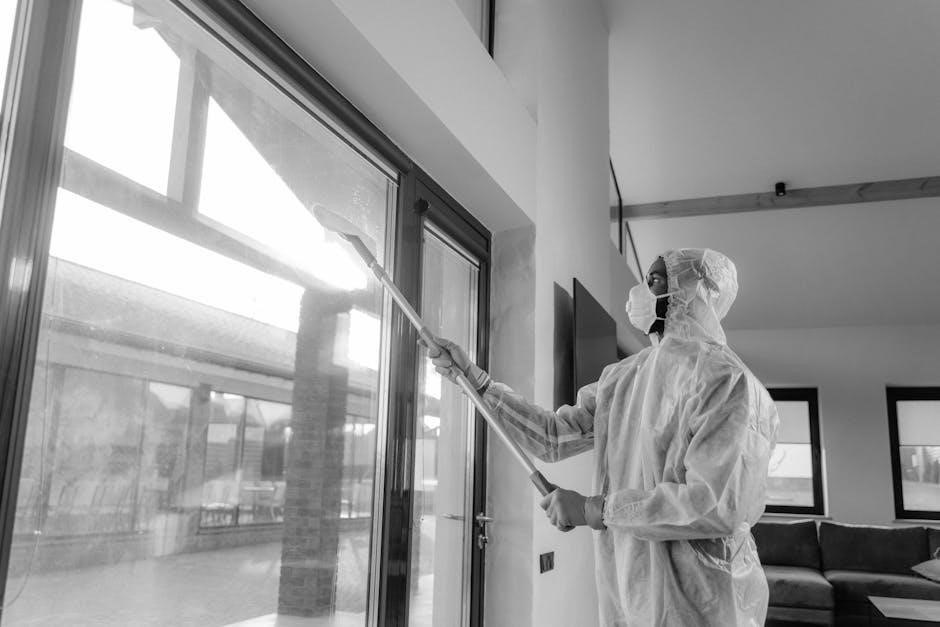The 2015 International Existing Building Code (IEBC) provides guidelines for modifying and maintaining existing structures, ensuring safety, health, and welfare through prescriptive and performance-based provisions․
1․1 Overview of the IEBC 2015
The 2015 International Existing Building Code (IEBC) is a comprehensive guide developed by the International Code Council (ICC) to address the unique challenges of maintaining and modifying existing structures․ It provides prescriptive and performance-related provisions to ensure safety, health, and welfare in existing buildings․ The code applies to repairs, alterations, additions, and changes of occupancy, offering flexible solutions for historic preservation and modern upgrades․ It is designed for architects, engineers, contractors, and code officials to ensure compliance with updated standards while balancing cost and practicality․
1․2 Importance of the IEBC for Existing Buildings
The IEBC 2015 is vital for ensuring the safety, accessibility, and sustainability of existing buildings․ It provides a framework for repairs, alterations, and modifications, helping buildings meet modern safety and energy standards․ Compliance with the code protects occupants, preserves historic structures, and reduces risks associated with outdated systems․ By addressing unique challenges of older buildings, the IEBC supports long-term sustainability, energy efficiency, and community resilience, making it essential for maintaining safe and functional built environments․
1․3 Key Features of the 2015 Edition
The 2015 IEBC introduces enhanced provisions for fire safety, structural repairs, and accessibility․ It incorporates updated energy efficiency standards and hazard mitigation requirements․ The code also includes clarified inspection and testing protocols, ensuring compliance with modern safety expectations․ New provisions address historic buildings and seismic retrofitting, while revised chapters streamline the retrofit process․ These features aim to balance safety, sustainability, and cost-effectiveness, making the 2015 edition a comprehensive resource for maintaining and upgrading existing structures․

Scope and Purpose of the IEBC 2015
The IEBC 2015 applies to existing buildings, ensuring safety and accessibility through specific provisions․ It covers alterations, repairs, and additions, referencing the International Building Code․
2․1 What the Code Covers
The IEBC 2015 provides provisions for the repair, alteration, addition, and change of occupancy in existing buildings․ It addresses fire safety, structural integrity, and accessibility, ensuring buildings remain safe and functional․ The code references the International Building Code (IBC) and International Residential Code (IRC) for specific requirements․ It also covers historic buildings and provides flexibility for retrofitting older structures․ The code ensures compliance with minimum safety standards without requiring full compliance with new building codes, balancing preservation and modernization․
2․2 Objectives of the Code
The primary objectives of the IEBC 2015 are to safeguard public health, safety, and welfare by ensuring existing buildings remain safe, functional, and sustainable․ The code aims to provide a regulatory framework for repairs, alterations, and changes in occupancy․ It promotes energy efficiency, accessibility, and hazard mitigation while preserving the building’s heritage․ The code also seeks to balance modern safety standards with the practical challenges of retrofitting older structures, ensuring buildings adapt to contemporary needs without compromising their historical value․
2․3 Application to Existing Buildings
The IEBC 2015 applies to existing buildings undergoing repairs, alterations, or changes in occupancy․ It provides flexible requirements to address the unique challenges of retrofitting older structures․ The code ensures that upgrades are proportionate to the work being done, avoiding unnecessary full compliance with new-building standards․ This approach balances safety, accessibility, and sustainability while preserving the building’s historical character․ Provisions focus on critical areas like structural integrity, fire safety, and energy efficiency to maintain functionality and extend the building’s lifespan․

Development and Publication of the IEBC 2015
The IEBC 2015 was developed through collaborative efforts by experts, ensuring updated safety standards․ It was published in 2015, available in both print and digital formats․
3․1 International Code Council (ICC) and Its Role
The International Code Council (ICC) is a nonprofit organization that develops and publishes model codes, including the IEBC․ Its primary role is to ensure buildings are safe, sustainable, and accessible․ The ICC facilitates collaboration among industry experts, governments, and stakeholders to create consensus-based codes․ For the IEBC 2015, the ICC oversaw the development process, ensuring it reflected current standards and best practices․ The organization is also responsible for maintaining and updating the code, providing resources for implementation and compliance․
3․2 Process of Code Development
The IEBC 2015 development involved a collaborative, consensus-based process․ The International Code Council (ICC) assembled technical committees to draft and review code provisions․ Public hearings and comment periods allowed stakeholders to provide input․ Revisions were based on new technologies, lessons from past events, and industry feedback․ The final document was approved by ICC members, ensuring it reflected broad expertise and met safety, accessibility, and sustainability goals․ This process ensures the code remains relevant and effective for existing buildings․
3․3 Key Stakeholders Involved
The development of the IEBC 2015 involved numerous stakeholders, including architects, engineers, building owners, and government agencies․ Contractors, code enforcement officials, and fire safety experts also contributed․ Additionally, advocacy groups focused on accessibility, sustainability, and historic preservation played a role․ These stakeholders ensured the code balanced safety, cost, and practicality, addressing diverse needs and ensuring broad applicability․ Their collective input helped shape the final document, making it a comprehensive resource for the industry․

Major Updates and Changes in the 2015 Edition
The 2015 IEBC introduced significant updates, enhancing provisions for accessibility, fire safety, and structural repairs․ New requirements for energy efficiency and hazard mitigation were also incorporated․
4․1 Revisions from Previous Editions
The 2015 IEBC includes revisions aimed at improving clarity and consistency with current standards․ Accessibility provisions were updated to align with ADA guidelines, enhancing usability for all occupants․ Fire safety measures were strengthened, particularly in historic buildings, to balance preservation with safety․ Structural repair requirements were refined, focusing on performance-based approaches․ Energy efficiency standards were updated to reflect advancements in technology․ Hazard mitigation provisions were expanded to address natural disasters more effectively, ensuring safer and more resilient existing buildings․
4․2 New Provisions and Requirements
The 2015 IEBC introduced new provisions to enhance safety, accessibility, and sustainability in existing buildings․ Key updates included enhanced accessibility standards, expanded requirements for energy efficiency, and new guidelines for structural repairs․ Provisions for seismic retrofitting were added to improve earthquake resistance․ Additionally, the code now includes specific requirements for historic buildings, ensuring their preservation while meeting modern safety standards․ These changes aim to modernize existing infrastructure without compromising its historical integrity․
4․3 Impact of Changes on Existing Buildings
The 2015 IEBC updates brought significant changes affecting existing buildings, requiring upgrades to meet new safety, accessibility, and efficiency standards․ Building owners faced increased costs for retrofits, while others benefited from clearer guidelines for historic preservation․ The changes encouraged modernization but posed challenges for structures with limited budgets․ Overall, the updates aimed to balance safety advancements with practical considerations for existing infrastructure, ensuring buildings remain safe and functional without compromising their historic or economic value․

Structure and Organization of the IEBC 2015
The 2015 IEBC is clearly organized into chapters and sections, covering administrative provisions, occupancy requirements, and technical specifications․ Appendices provide supplementary guidance for specific scenarios and compliance methods․
5․1 Layout and Format of the Code
The 2015 IEBC is structured into clear chapters and sections, ensuring easy navigation․ It begins with administrative provisions, followed by technical requirements for existing buildings․ Each chapter focuses on specific aspects like occupancy classifications, structural repairs, and fire safety․ The code uses standardized headings, tables, and cross-references for clarity․ Appendices offer supplementary guidance, while indexes and tables of contents enhance accessibility․ This logical organization helps users quickly locate relevant information, facilitating compliance and effective application of the code․
5․2 Key Chapters and Sections
The 2015 IEBC includes essential chapters addressing specific aspects of existing buildings․ Chapter 1 covers administration, while Chapter 2 focuses on occupancy classifications and requirements․ Chapter 3 details structural design and repair standards, ensuring safety and stability․ Chapters 4 through 6 address fire safety, accessibility, and energy efficiency, providing clear guidelines for compliance․ These sections are critical for understanding and applying the code effectively to existing buildings, ensuring they meet modern safety and functionality standards while respecting their historical or structural constraints․
5․3 Navigation Tips for Users
Navigating the 2015 IEBC requires a systematic approach․ Start with the index and table of contents to locate specific topics quickly․ Pay attention to cross-references, which guide users to related sections․ Use the appendices for supplementary information and definitions․ Familiarize yourself with key terminology in Chapter 2․ Utilize the ICC’s official commentaries for clarification․ Prioritize sections relevant to your project, such as fire safety or accessibility․ Regularly update your knowledge with ICC resources and updates to ensure compliance and efficiency in applying the code․

Key Provisions of the IEBC 2015
The 2015 IEBC focuses on fire safety, structural repairs, accessibility, energy efficiency, and hazard mitigation․ It ensures existing buildings meet modern safety and sustainability standards․
6․1 Fire Safety Requirements
The 2015 IEBC includes detailed fire safety measures to protect occupants and property․ Requirements cover means of egress, fire suppression systems, and fire alarm installations․ Existing buildings must meet updated standards for fire-resistant materials and compartmentalization․ Retroactive upgrades are often required to ensure compliance with modern fire safety codes․ The code also addresses unique challenges in historic buildings while maintaining safety․ Provisions ensure that existing structures are retrofitted with necessary fire protection systems to minimize risks and enhance emergency response capabilities․
6․2 Structural Integrity and Repairs
The 2015 IEBC emphasizes maintaining and restoring structural integrity in existing buildings․ It provides guidelines for evaluating structural systems, identifying deficiencies, and performing necessary repairs․ Provisions address material degradation, seismic retrofits, and load-bearing capacity․ Engineered repairs must comply with current standards, ensuring safety and durability․ The code also allows for alternative methods to preserve historic structures while meeting modern safety requirements․ Regular inspections and documentation are mandated to verify structural stability and compliance with the code․
6․3 Accessibility Standards
The 2015 IEBC includes updated accessibility requirements to ensure equitable access for all users․ Key provisions include tactile signage, wheelchair-accessible routes, and clear floor space in dwelling units․ Stairways, elevators, and restrooms must meet specific dimensions for accessibility․ The code aligns with ADA standards while addressing unique challenges in existing buildings․ Retrofits must maintain historic integrity where possible, with alternatives permitted when full compliance is impractical․ These updates enhance inclusivity and usability for individuals with disabilities․
6․4 Energy Efficiency and Sustainability
The 2015 IEBC emphasizes energy efficiency and sustainability in existing buildings․ It includes requirements for upgrading HVAC systems, lighting, and water heating to meet modern standards․ Provisions encourage the use of renewable energy systems and improved insulation․ The code also promotes water conservation through efficient fixtures․ Incentives are provided for voluntary upgrades, aligning with broader sustainability goals․ These updates help reduce operational costs and environmental impact while maintaining building functionality and performance․
6․5 Hazard Mitigation Provisions
The 2015 IEBC includes provisions to enhance hazard mitigation in existing buildings․ Requirements address seismic retrofits, flood risk reduction, and windborne debris protection․ The code provides guidelines for assessing and improving structural resilience․ Retrofits for critical facilities, such as hospitals, are prioritized․ Provisions also cover the use of impact-resistant materials and elevation of electrical systems in flood-prone areas․ These measures aim to reduce risks and enhance community resilience against natural disasters while maintaining building functionality and occupant safety․

Enforcement and Compliance with the IEBC 2015
Enforcement involves code enforcement agencies monitoring compliance, conducting inspections, and reviewing plans․ Non-compliance can result in penalties, ensuring safety and adherence to the code’s requirements․
7․1 Role of Code Enforcement Agencies
The role of code enforcement agencies is to ensure compliance with the IEBC 2015 by reviewing plans, conducting inspections, and enforcing safety standards․ These agencies interpret and apply the code to existing buildings, addressing repairs, alterations, and changes in occupancy․ They work with building owners, contractors, and designers to resolve compliance issues․ Enforcement agencies also provide guidance on retrofitting older buildings to meet current safety and accessibility requirements, ensuring public safety and structural integrity․ Their role is critical in maintaining the integrity of the built environment․
7․2 Inspection and Certification Processes
Inspection and certification processes under the IEBC 2015 ensure existing buildings meet safety and code requirements; Inspections are conducted to assess structural integrity, fire safety, and accessibility․ Certified professionals evaluate buildings to identify hazards and verify compliance․ The certification process involves documenting findings and recommending repairs or upgrades․ Regular inspections help maintain building performance and safety over time․ This process supports compliance with the code while minimizing unnecessary upgrades, ensuring buildings remain safe and functional․
7․3 Consequences of Non-Compliance
Non-compliance with the IEBC 2015 can lead to severe penalties, including fines and legal action․ Buildings may face closure or restricted use until violations are corrected․ Safety risks increase, endangering occupants and potentially leading to liability․ Non-compliance can also result in higher insurance costs and reputational damage․ Authorities may mandate costly retrofits or upgrades to achieve compliance․ Failure to adhere to the code undermines public safety and can have long-term financial and operational consequences for building owners and managers․

Relationship with Other ICC Codes
The IEBC 2015 aligns with other ICC codes like IBC and IRC, ensuring coordinated requirements for new and existing buildings, avoiding duplication and enhancing compliance efficiency․
8․1 International Building Code (IBC)
The IEBC 2015 works in tandem with the IBC, which focuses on new construction․ While the IBC sets standards for building design and safety, the IEBC addresses existing structures, ensuring retrofits and alterations meet modern safety and accessibility requirements․ Together, they provide a comprehensive framework for buildings throughout their lifecycle․ The IEBC often references IBC provisions, particularly in areas like fire safety, structural integrity, and accessibility, to maintain consistency and harmonization between new and existing buildings․
8․2 International Residential Code (IRC)
The IRC primarily governs one- and two-family dwellings, while the IEBC focuses on existing buildings․ Both codes share the goal of ensuring safety and accessibility but apply to different contexts․ The IEBC often references IRC standards for residential renovations, particularly in areas like energy efficiency, fire safety, and structural repairs․ This integration helps maintain consistency across new and existing residential buildings, ensuring compliance with modern safety standards while respecting the unique challenges of retrofitting older structures;
8․3 Integration with Other Codes and Standards
The IEBC 2015 is designed to work seamlessly with other ICC codes and standards to ensure comprehensive safety and compliance․ It cross-references the International Building Code (IBC), International Residential Code (IRC), and other standards to maintain consistency․ This integration helps address gaps in safety, accessibility, and energy efficiency․ By aligning with other codes, the IEBC promotes a unified approach to building safety, making it easier for professionals to meet multiple regulatory requirements effectively․

Case Studies and Real-World Applications
Real-world applications of the IEBC 2015 demonstrate its effectiveness in retrofitting and upgrading existing buildings, ensuring safety and compliance while preserving historical integrity and promoting sustainability․
9․1 Successful Retrofits and Upgrades
A historic office building in Chicago successfully implemented IEBC 2015 guidelines for seismic retrofitting, enhancing structural stability while maintaining its architectural heritage․ The project utilized provisions for load-bearing wall reinforcements and updated fire suppression systems, ensuring compliance without compromising aesthetics․ Energy efficiency upgrades, such as window replacements and insulation improvements, were also integrated, reducing operational costs and environmental impact․ This case highlights how IEBC 2015 balances safety, sustainability, and preservation in retrofitting existing structures․
9․2 Lessons Learned from Code Implementation
Implementation of the IEBC 2015 has revealed key lessons, including the importance of early stakeholder collaboration and clear communication between architects, contractors, and code officials․ Projects often face delays due to misunderstood requirements, emphasizing the need for thorough pre-planning․ Balancing historic preservation with modern safety standards remains a significant challenge, requiring creative solutions․ Successful implementations highlight the value of proactive compliance strategies and the benefits of integrating energy-efficient upgrades early in the process to enhance sustainability and reduce long-term costs․
9․3 Examples of Compliance Challenges
Compliance with the IEBC 2015 often poses challenges, particularly in retrofitting older buildings to meet modern safety and accessibility standards․ Fire-resistance ratings for existing structural elements can be difficult to verify without destructive testing․ Additionally, upgrading older electrical and plumbing systems to current codes while maintaining building functionality is costly․ Historic buildings face unique challenges in preserving character while meeting accessibility requirements, leading to complex negotiations between stakeholders․ These issues highlight the need for tailored solutions and flexible enforcement approaches․
Resources and Support for IEBC 2015 Users
The IEBC 2015 provides official commentaries, training programs, and online forums to aid users in understanding and applying the code effectively․
10․1 Official Code Commentaries
The 2015 IEBC provides official commentaries to clarify code intent and implementation․ These resources offer detailed explanations, case studies, and examples to help users interpret and apply the code effectively․ Available in formats like international existing building code 2015 pdf, the commentaries are invaluable for architects, engineers, and code officials․ They cover key updates, such as fire safety and accessibility, ensuring compliance and understanding․ These documents are authored by code experts, making them authoritative guides for navigating the IEBC 2015․
10․2 Training and Educational Resources
The 2015 IEBC offers comprehensive training and educational resources to help users master the code․ These include webinars, workshops, and online courses tailored for architects, engineers, and building officials․ The International Code Council (ICC) provides these resources to ensure professionals understand updates and requirements․ Many materials are accessible online, with some available as international existing building code 2015 pdf documents․ These tools promote compliance and enhance skills in applying the code effectively to existing buildings․
10․3 Technical Support and FAQs
The 2015 IEBC provides robust technical support and FAQs to address user inquiries․ The ICC website offers detailed FAQs, clarifying code interpretations and application․ Technical support is available through forums, emails, and phone assistance․ These resources help resolve compliance issues and interpret complex provisions․ Additionally, the international existing building code 2015 pdf includes cross-references and explanatory notes, aiding users in understanding and applying the code effectively․ These tools ensure accurate implementation of the IEBC standards․

Future of the International Existing Building Code
The 2015 IEBC sets the stage for future updates focusing on sustainability and technology․ It will likely include more on energy efficiency and disaster resilience, adapting to new challenges while maintaining safety and accessibility․ The code’s evolution will ensure buildings remain safe and efficient, supporting sustainable development as standards advance;
11․1 Emerging Trends in Building Codes
The International Existing Building Code (IEBC) 2015 reflects emerging trends in building codes, emphasizing sustainability, energy efficiency, and disaster resilience․ Advances in technology and materials are driving updates, with a focus on adapting existing structures to meet modern safety and environmental standards; The code incorporates lessons from past natural disasters, promoting retrofitting and upgrades to enhance building performance․ As sustainability becomes a priority, future editions will likely integrate more green building practices and energy-efficient requirements, ensuring buildings remain safe, functional, and environmentally friendly․
11․2 Potential Updates and Revisions
Potential updates to the IEBC 2015 may focus on enhancing accessibility, energy efficiency, and structural safety․ Future revisions could incorporate advancements in materials science and technology, such as improved fire-resistant materials or seismic retrofitting techniques․ Stakeholder feedback and lessons from real-world applications are expected to shape these changes․ The ICC may also align the code more closely with other international standards, ensuring consistency and adaptability for diverse building types․ These updates aim to address evolving challenges and improve compliance processes․
11․3 Role of IEBC in Sustainable Development
The IEBC 2015 plays a pivotal role in promoting sustainable development by integrating energy-efficient practices and green building standards․ It encourages the reuse and retrofitting of existing structures, reducing demolition waste and environmental impact․ By aligning with sustainability goals, the code supports the conservation of resources and reduces carbon footprints․ Provisions for renewable energy systems and water conservation further enhance its contribution to creating environmentally responsible buildings․ This focus aids in achieving long-term ecological and economic benefits for communities․
